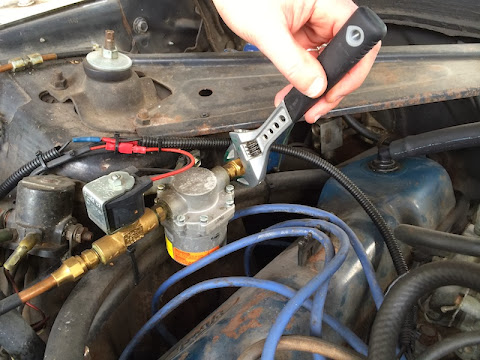The ugliest part of my LPG kit is the air cleaner. It also sits on top of the carb and I need to know the type so the air cleaner needs to go. And because the fuel valve (also part of the LPG kit) is screwed to the air cleaner, it's going as well!
Above you see the "before" picture. U-G-L-Y...
I removed the air cleaner and finally managed to figure out what carburetor I got: A Holley 80457-2. Nice!
It's gonna need a bath at some point though but for now I'm leaving it in place. One thing I wasn't happy about is that they removed the choke plate when installing the LPG, an unpleasant surprise...
Then all I needed to do was replacing the fuel hose and valve with a new bit of hose.
And why not? I mounted my new air cleaner. It fits perfectly!
Doesn't this look a hell of a lot better than before?
Wednesday, January 29, 2014
Saturday, January 18, 2014
Removing my LPG tank
Today was a good day to remove my LPG tank. This was a job that made me very nervous since it had to do with volatile and flammable gas. But the weather was great and I was getting help from my best friend and good tips from some of the folks over at the Dutch Mustang & Ford Forum.
I drove the car outside as that is safer than doing this job indoors.
Mainly you deal with 2 (pipe)lines. The one from the filler port to the tank and the one from the tank to the engine. Both lines can be under pressure depending on wether or not they are closed by a valve on either end.
My biggest fear were malfunctioning valves, especially those on the tank. I thought the valves on the line to the engine would be the most trouble-free so I started with that one.
I rather released the gas from the engine-bay, which I did. This hissed for about 5-10 minutes and then it stopped. Good start!
In the trunk I first removed the air-hose from the tank and also I cut electricity to the electric valve.
I then disconnected the line to the engine from the tank. The wiring had to be pulled back out of the seal. Since I had released the pressured gas this was easy.
Now it was time for my new super sexy red gloves. Because they are made for working with liquids, they are also very suitable for poking your nose! ;-)
I put on the gloves just in case liquid LPG would spray out. This is quite cold you see.
Now the scary bit: disconnecting the filler line. This has a mechanical valve on the tank that not always closes properly because sometimes the line remains pressurised after filling the tank up.
To loosen up the valve I whacked it with a hammer a few times (not toooo hard!).
It was fixed very tight and I had to use quite some force to loosen it but in the end it gave way. This was a bit of an anti-climax as it only hissed for a few seconds and that's it. So thankfully I had a working valve and not a lot of pressure remaining in the pipeline :-)
Here is the whole tank disconnected. Yay! This took maybe 30-45 minutes, but only because we worked slow and very careful.
Since everything went so quick we decided to also remove the bracket and later we even removed all the pipelines.
One tank. And only some LPG parts left under the bonnet.
Great stuff!
I drove the car outside as that is safer than doing this job indoors.
Mainly you deal with 2 (pipe)lines. The one from the filler port to the tank and the one from the tank to the engine. Both lines can be under pressure depending on wether or not they are closed by a valve on either end.
>>>>>>>>>> Don't forget to disconnect your battery <<<<<<<<<<
My biggest fear were malfunctioning valves, especially those on the tank. I thought the valves on the line to the engine would be the most trouble-free so I started with that one.
I rather released the gas from the engine-bay, which I did. This hissed for about 5-10 minutes and then it stopped. Good start!
In the trunk I first removed the air-hose from the tank and also I cut electricity to the electric valve.
I then disconnected the line to the engine from the tank. The wiring had to be pulled back out of the seal. Since I had released the pressured gas this was easy.
Now it was time for my new super sexy red gloves. Because they are made for working with liquids, they are also very suitable for poking your nose! ;-)
I put on the gloves just in case liquid LPG would spray out. This is quite cold you see.
Now the scary bit: disconnecting the filler line. This has a mechanical valve on the tank that not always closes properly because sometimes the line remains pressurised after filling the tank up.
To loosen up the valve I whacked it with a hammer a few times (not toooo hard!).
It was fixed very tight and I had to use quite some force to loosen it but in the end it gave way. This was a bit of an anti-climax as it only hissed for a few seconds and that's it. So thankfully I had a working valve and not a lot of pressure remaining in the pipeline :-)
Here is the whole tank disconnected. Yay! This took maybe 30-45 minutes, but only because we worked slow and very careful.
Since everything went so quick we decided to also remove the bracket and later we even removed all the pipelines.
One tank. And only some LPG parts left under the bonnet.
Great stuff!















